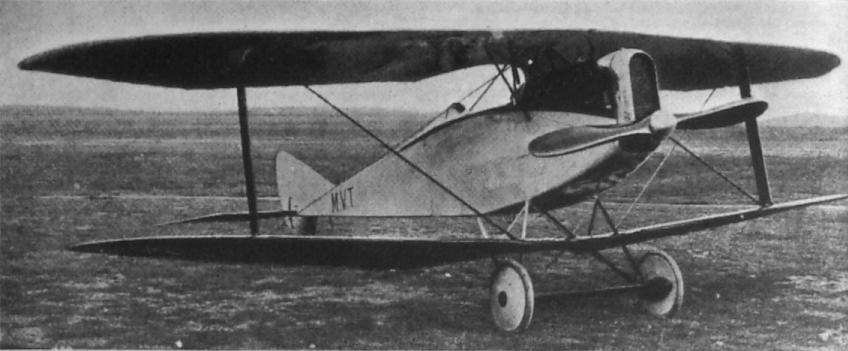W.Green, G.Swanborough The Complete Book of Fighters
MARCHETTI MVT (S.50) Italy
Designed by Alessandro Marchetti and built by the Vickers-Terni industrial organisation at La Spezia, the MVT single-seat fighter biplane was flown in 1919. Of all-metal construction, the MVT was powered by a 220 hp SPA 6a water-cooled engine and carried an armament of two synchronised Vickers machine guns. The fuselage, which was suspended between the upper and lower mainplanes, was flattened aft to emulate an aerofoil surface, and the semi-elliptical wings were of extremely thin section, lateral control being provided by wing warping. On 9 December 1919, the MVT recorded a speed of 155 mph (250 km/h) - absence of FAI officials preventing this being certified as a world speed record - and demonstrated the ability to climb to 16,405 ft (5 000 m) in 11 min. In 1920, the MVT was fitted with longer-span wings, splayed interplane bracing struts, a revised cabane and a redesigned horizontal tail. A 285 hp SPA 62a engine was fitted with which 171 mph (275 km/h) was attained under test at Montecelio. When Marchetti was appointed chief designer to SIAI, the MVT was redesignated S.50 and was entered in the official fighter contest of 1923. Three were supplied to the newly-created Regia Aeronautica for evaluation, but a plan to procure a batch of 12 failed to materialise. One S.50 was modified as a twin-float seaplane. The following data relate to the SPA 62a-powered MVT.
Max speed, 155 mph (250 km/h).
Time to 3,280 ft (1 000 m), 2.0 min.
Endurance, 2.1 hrs.
Empty weight, 1,647 lb (747 kg).
Loaded weight, 2,176 lb (987 kg).
Span, 28 ft 6 1/2 in (8,70 m).
Length, 25 ft 5 1/8 in (7,75 m).
Height, 8 ft 6 1/3 in (2,60 m).
Wing area, 231.43 sq ft (21,50 m2).
J.Davilla Italian Aviation in the First World War. Vol.3: Aircraft M-W (A Centennial Perspective on Great War Airplanes 75)
Marchetti MVT/S.50
Designed by Alessandro Marchetti of the Vickers-Terni firm in La Spezia.The fuselage had a metal interior structure with bronze joints and was fabric covered. The sharply tapered fuselage was suspended between the wings. The narrowing of the fuselage from behind the cockpit was apparently intended to improve the pilot’s rearward view.
It was intended that the aircraft could be rapidly disassembled and transported. The wing interior was also constructed of metal with steel spars; the top wing had a pronounced sweepback. A simple “I” strut on either side of the wing provided support along with sheathed cable rigging.
The engine was an SPA 6A. Oddly, the M.V.T. (Marchetti Vickers-Terni) used wing warping of the wing tips for lateral control instead of ailerons as used by virtually all Italian fighters at that time. It was powered by a high-compression SPA 6a engine developing 220-hp with car-type radiator. It drove a wooden two blades propeller with a spinner. The landing gear protruded from the fuselage through a cut out in the leading edge of the lower wing. There was a conventional fin attached to a large rudder. There were elevators, but no horizontal stabilizers.
The M.V.T. was flown in September 1918 by sergente Liut; as testing continued the aircraft was claimed to have reached 260 km/h at Montecelio, although this was, and still remains, unverified. In 1919 a speed of 275-hp was reportedly reached with a newly fitted 285 hp SPA 6-2a engine.
Work stopped postwar until Marchetti joined SIAI and resumed development as the S.50. This was the first landplane for the SIAI firm.
The S.50’s received in 1923 serials 11, 12, 13 which, in the system adopted by the Regia Aeronautica, indicated experimental aircraft. An order of 12 examples was announced in 1922 but as far as can be determined they were never built.
SIAI modified an S.50 as a floatplane to participate in the 1922 edition of the Schneider Trophy in Naples. Still called S.50, this aircraft carried two big flat bottomed floats attached to the undercarriage legs and, with a “V” strut, to the underside of the fuselage. It had a new rudder, with a larger fin that projected underneath the fuselage, while the upper portion had been deleted. The modified S.50 crashed during a test flight over the Lake Maggiore. Test pilot Umberto Guarnieri, survived this accident, while the M.V.T. S.50s career did not.
S.50 Single-Seat Fighter with One 220-hp SPA 6A S.s.c. Engine
Wingspan 8.70 m; Length 7.25 m; Height 2.60 m; Wing surface area 21.5 sq m
Empty weight 740 kg; payload 240 kg; loaded weight 987 kg.
Maximum speed 250 km/h; Climb to 1000 m in 2 minutes; Climb to 2000 m in 4’36”; Climb to 3000 m in 8 minutes; Climb to 4000 m in 12’12”; Climb to 5000 m in 23’40”; Ceiling 7550 m; Endurance 2h 6’







